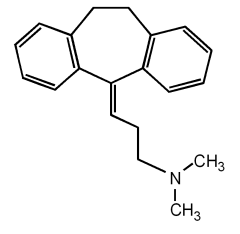Tricyclic antidepressant
|
|
Tricyclic antidepressants are a class of antidepressant drugs first used in the 1950s. They are named after the drugs' molecular structure, which contains three rings of atoms (compare tetracyclic antidepressant). The term 'tricyclic antidepressant' is sometimes abbreviated to TCA.
| Contents |
Mechanism of Action
It was thought that tricylic antidepressants work by inhibiting the re-uptake of the neurotransmitters norepinephrine and serotonin by nerve cells. However, this response occurs immediately, however mood does not lift for around two weeks. It is now thought that changes occur in receptor sensitivity in the cerebral cortex and hippocampus. The hippocampus is part of the limbic system, an extremely old (in evolutionary terms) part of the brain involved in emotions. Presynaptic receptors are affected: α1 and β1 receptors are sensitised, α2; receptors are desensitised (leading to increased noradrenaline production).
Clinical Usage: Treatment of Depression
For many years they were the first choice for pharmacological treatment of depression. Although they remain effective, they have been increasingly replaced by SSRIs and other newer drugs. These newer antidepressants are thought to have fewer side effects and are also thought to be less effective if used in a suicide attempt, as the treatment and lethal doses are much further apart than with the tricyclic antidepressants. The reason why tricyclic antidepressants are still used is their high potency, especially in severe cases of clinical depression. They are not considered addictive and have many fewer side-effects and restrictions than the MAOIs. Although (anti-muscarinic) side effects appear almost straight-away, depression does not lift for a fortnight. This can be dangerous, as volition is increased, giving the patient greater ability to attempt suicide. Sleep also improves reasonably quickly.
Clinical Usage: Analgesia
Tricyclics are also known as effective analgesics for different types of pain, especially neuropathic or neuralgic pain (like back pain in radiculitis). A precise mechanism for their analgesic action is unknown, but it is thought that they modulate anti-pain opioid systems in CNS via indirect serotonergic route. They are also effective in migraine prophylaxis, but not in abortion of acute migraine attack. The mechanism of their anti-migraine action is also thought to be serotonergic.
Side Effects
Many side effects are related to anti-muscarinic properties. These include:
- Dry mouth (salivary secretion is affected)
- Blurred vision (accommodation in the eye is affected)
- Decreased gastro-intestinal motility and secretion. This may lead to constipation.
Partial resistance to these effects develops within about two weeks. They may be beneficial, as they indicate to the patient that the drugs are having an effect. Other side effects may include drowsiness, anxiety, restlessness, urinary retention or difficulty with urination, cognitive and memory difficulties, weight gain, sweating, dizziness, hypotension, akathisia, decrease in sexual ability and desire, muscle twitches, weakness, nausea, increased heart rate and irregular heart rhythms (rare). Some of these side effects relate to their anti-muscarinic properties.
It is worth noting that many people suffer few, if any, side effects from taking tricyclic antidepressants. However, as with any medication, it is always worth reporting any problems you encounter to your health care provider.
Example Compounds
The first tricyclic antidepressant discovered was imipramine, which was discovered accidentally in a search for a new antipsychotic in the late 1950s.
Antidepressant drugs in the tricyclic drug group include:
- amitriptyline (Elavil®, Endep®)
- amoxapine (Asendin®)
- clomipramine (Anafranil®)
- desipramine (Norpramin®, Pertofrane®)
- dothiepin hydrochloride (Prothiaden®, Thaden®)
- doxepin (Adapin®, Sinequan®)
- imipramine (Tofranil®)
- lofepramine (Gamanil®, Lomont®)
- nortriptyline (Pamelor®)
- protriptyline (Vivactil®)
- trimipramine (Surmontil®)

